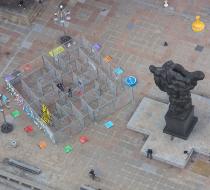A Maze in Philadelphia Focuses Attention on the Hidden Cruelty of US Prisons Favorite
The US prison system is one of the world’s great shames. A quarter of the world’s prisoners are being detained in a country that represents only 5% of the world’s population. It is a system that has been compared to a modern-day version of the Jim Crow laws. Through the work of activists and human rights defenders, we’re seeing more and more evidence that the prisons represent a dysfunctional system that perpetuates white supremacy and victimizes the poor in the United States.
This month, a public art project organized by the Mural Arts Program in Philadelphia, Open Source, explores aspects of the city’s urban identity including the troubling impact of the prison-industrial complex. Curated by Pedro Alonzo, the 14 projects of Open Source tackle what the curator described to Hyperallergic as “Philadelphia’s essential character.”
Responses to that essential character have included Michelle Angela Ortiz’s ambitious “Familias Separadas” (“Separated Families”) (2015) project, which amplified the tragic stories of undocumented families whose lives are affected by deportations, and Jonathan Monk’s two skateable sculptures based on concrete works by minimalist Sol LeWitt that challenged preconceived notions of how an audience interacts with public art. Open Source also includes Sam Durant‘s “Labyrinth” (2015).
Durant is an artist who seems to easily navigate the boundaries between politics and contemporary art. His work often pokes at official histories to raise questions about authority, power, and representation. For “Labyrinth,” the LA-based artist did something he had never done before: he started with a rough idea and allowed his process, which included consultations with inmates at Graterford maximum security state prison, to mold the result. “It was scary to start a project without any idea of what will happen and trusting the project to see how things would change,” Durant said.
Eventually Durant decided, with input from the inmates, curator, and Mural Arts, to tackle the quagmire of criminal justice by placing “Labyrinth” (2015), a 40-by-40-foot maze made of chain link fencing, across the street from Philadelphia’s City Hall in Thomas Paine Plaza. The location is important, as it becomes a prominent symbol under the nose of the city’s seat of power, but it is also a place that Philadelphia blogger Jon Geeting has called a “failed public space.” Open areas like this, sandwiched between prominent buildings, are rarely inviting and often run down. If such prominent urban spaces are neglected, the project seems to say, then imagine the public’s blindness to the lives of inmates who are forcibly detained and isolated from the public.
While “Labyrinth” was bare when it was unveiled on October 1, the work has slowly changed as members of the public placed items on the barriers as commentary on the larger social issue of incarceration. Works by inmates, their families, concerned citizens, street artists, and others have slowly accumulated on the fence and have turned the initially transparent structure into something with obstructions and visual barriers.
“The main challenge is the ways in which the piece is activated,” Durant told Hyperallergic months before the project opened. He hoped that the interaction would be meaningful to the inmates and the people walking by, and he said that would be his gauge for the piece’s success.
The symbolism of a maze or labyrinth is deeply embedded in various mythic traditions. In Ancient Greece, what might be the most famous labyrinth trapped the Minotaur, a masculine creature with the head of a bull and body of a man, who could never escape its twists and turns. The meaning is obvious — the US penal system rendered as a largely useless disorienting structure. For the artist, the ability to communicate directly to those passing by drove the form, while complementary events (like an artist talk and a workshop) augmented the message.
While a work like Durant’s might be construed as too controversial in other cities, Mural Arts is a unique organization that has been continuously pushing the parameters of art in the public sphere in Philadelphia.
“It’s about the social power that art has,” Jane Golden, executive director of Mural Arts, said during an interview with Hyperallergic. “Politics for me is about change. When we pigeonhole what political art is then we’re doing a disservice to the artist because there are many ways change can happen.” It’s a refreshing approach to the relationship between art and politics.
“To me, Mural Arts is bread and roses in practice, it’s like survival and beauty,” Durant said. “It’s a pilot for the way all cities can be, and the government can operate. It’s about bringing life and beauty … creativity and imagination … to our social and political institutions. It’s really unique.”
“Labyrinth” is as much about trying out the language of public art in a way that relishes the process as it is about the finished work. While the fences of the maze never became as saturated with public messages as the artist may have originally imagined, there are a number of poignant message nonetheless. One, signed S.M. Rodriguez, reads, “We are losing out future.” Another, written by Mary Lewis, reads, “I never want to be on the inside again.”
Durant has placed the blight of incarceration in the public’s face; the choice to ignore it or take action is your choice.
Via http://hyperallergic.com/249555/a-maze-in-philadelphia-focuses-attention...












